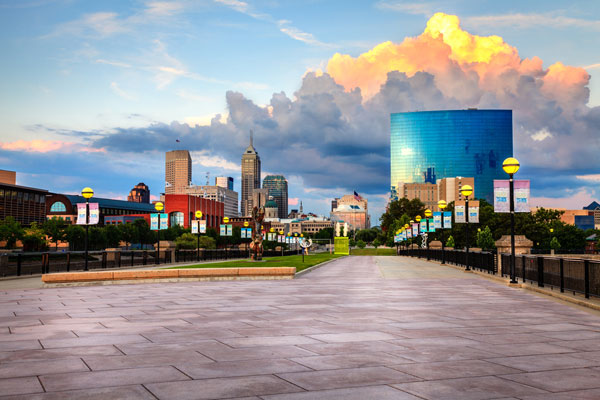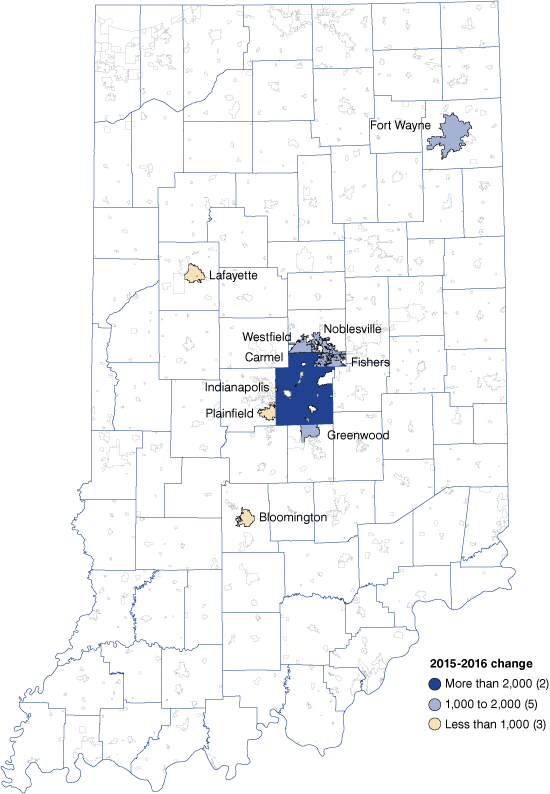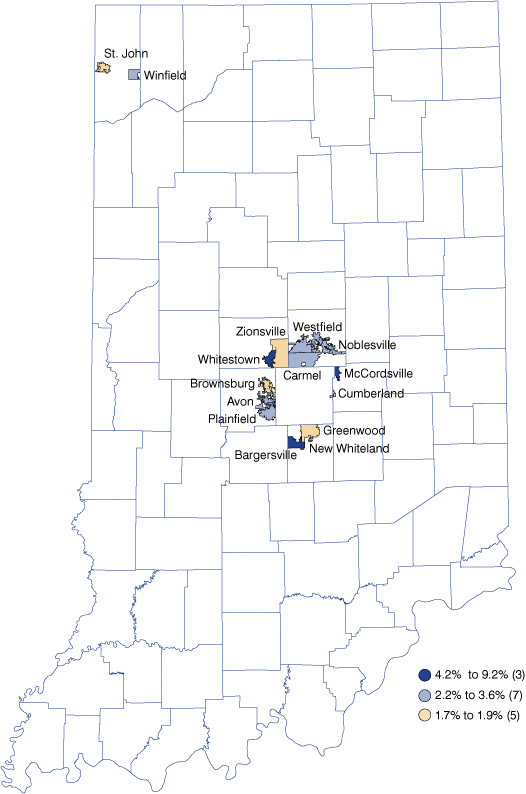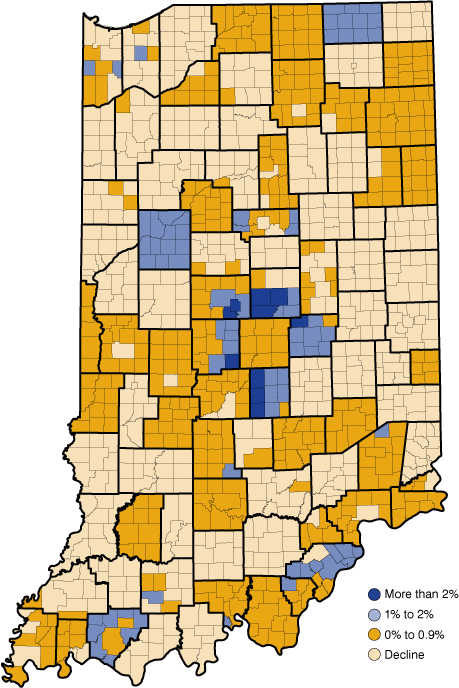Carmel, Indianapolis and Fort Wayne show biggest 2016 population gains

With a population of 855,164 residents, Indianapolis was the nation's 15th-largest city in 2016.
Seven Indiana cities posted annual population increases of more than 1,000 residents in 2016, according to U.S. Census Bureau estimates.1
Carmel led with an addition of 2,977 people last year, followed by gains in Indiana’s two largest cities. Indianapolis added an estimated 2,869 people, and Fort Wayne grew by 1,682 residents from 2015 to 2016.
More suburban Indianapolis communities claimed the next five spots: Noblesville, with an increase of 1,562 residents in 2016; Westfield, 1,285 residents; Fishers, 1,147 residents; Greenwood, 1,073 residents; and Plainfield, 834 residents.
Lafayette, which grew by 700 residents, and Bloomington, which had 672 additional people, rounded out the top 10 (see Figure 1).
Figure 1: Cities with largest population growth, 2015-2016

Source: IBRC, using U.S. Census Bureau data
Among Indiana cities or towns with at least 5,000 residents, Whitestown in Boone County was the state’s fastest-growing community in 2016 with a growth rate of 9.2 percent. This marks the sixth consecutive year that Whitestown has ranked as the state’s fastest-growing locale. Over that span, Whitestown’s population has more than doubled from 3,147 in 2010 to 6,590 in 2016.
For the second year in a row, McCordsville in Hancock County was Indiana’s second-fastest-growing place, with a growth rate of 7.2 percent in 2016, followed by Bargersville in Johnson County (4.2 percent growth), and Hamilton County’s Westfield (3.6 percent) and Carmel (3.4 percent).
In all, 13 of the 15 fastest-growing cities or towns in the state in 2016 were in suburban counties in the Indy metropolitan area (see Figure 2). The only places outside Central Indiana to make the top 15 were the Lake County communities of Winfield (2.9 percent) and St. John (1.9 percent).Figure 2: Indiana’s fastest-growing cities and towns, 2015-2016

Source: IBRC, using U.S. Census Bureau data
Indiana's largest cities
With a population of 855,164 residents, Indianapolis was the nation's 15th-largest city in 2016, ranking just behind Columbus, Ohio, (860,090) and ahead of Fort Worth, Texas (854,113).
Indianapolis had seen something of a population growth surge earlier in this decade, adding an average of 6,775 residents per year from 2010 to 2014, but growth in the Circle City has slowed of late, with an average annual gain of roughly 3,200 residents over the past two years. Indianapolis grew by an average of about 3,800 residents each year from 2000 to 2010.
Fort Wayne has seen remarkably steady population growth over the past six years. Indiana's second-largest city added 1,682 residents in 2016 to bring its total population to an estimated 264,488. Fort Wayne's growth in 2016 was just a shade lower than its average annual growth of 1,739 per year from 2010 to 2015.
Evansville (population 119,477) and South Bend (101,735) are the only other Indiana cities with a population above 100,000 residents. These two communities have experienced opposing growth trends so far this decade.
Evansville added an average of 139 residents per year from 2010 to 2013 but has seen an average annual decline of 354 residents over the past three years. 2016 marked Evansville's largest drop over this stretch, with a loss of 561 residents.
South Bend, by contrast, had essentially flat population change from 2010 to 2013 but has added an average of 236 residents per year over the past three years.Before posting a nearly 3,000-person gain in population last year, Carmel, the state's fifth-largest city, added on average 1,660 residents per year from 2010 to 2015. Table 1 shows the state’s 10 largest cities, along with their population change since 2015.
Table 1: Indiana’s 10 largest cities, 2016
| City | 2016 | Change since 2015 | |
|---|---|---|---|
| Number | Percent | ||
| Indianapolis | 855,164 | 2,869 | 0.3% |
| Fort Wayne | 264,488 | 1,682 | 0.6% |
| Evansville | 119,477 | -561 | -0.5% |
| South Bend | 101,735 | 204 | 0.2% |
| Carmel | 91,065 | 2,977 | 3.4% |
| Fishers | 90,127 | 1,147 | 1.3% |
| Bloomington | 84,465 | 672 | 0.8% |
| Hammond | 77,134 | -512 | -0.7% |
| Gary | 76,424 | -692 | -0.9% |
| Lafayette | 71,782 | 700 | 1.0% |
Source: IBRC, using U.S. Census Bureau data
Thirteen of the state's 20 largest cities posted population gains in 2016. Of this group, the four fastest-growing communities were in the Indianapolis metro area, led by Carmel (3.4 percent growth in 2016), Noblesville (2.7 percent), Greenwood (1.9 percent) and Fishers (1.3 percent). Other fast-growing larger cities include Lafayette (1.0 percent), Mishawaka (1.0 percent), Bloomington (0.8 percent) and Jeffersonville (0.8 percent).
At the other end of the spectrum, Evansville, Gary and Hammond had the state's largest declines in 2016.
For Gary, the decline in population of 692 residents in 2016 was the continuation of a sharp, years-long population slide. According to the U.S. Census Bureau, Gary's population has fallen by more than 25 percent in the past 16 years, from 102,746 at the time of the 2000 census to an estimated 76,424 in 2016. Gary was Indiana's fifth-largest city in 2000 but ranked as the state's ninth-largest community in 2016. Hammond's population dropped by 512.
Townships
In 2016, 480 of Indiana's 1,010 townships either held steady or added population (see Figure 3). More than half of the state's townships registered a loss last year, with 54 of them declining at a rate of 1 percent or more.
Figure 3: Percent change in township population, 2015-2016

Source: IBRC, using U.S. Census Bureau data
For more data, visit the Population topic page at STATS Indiana.